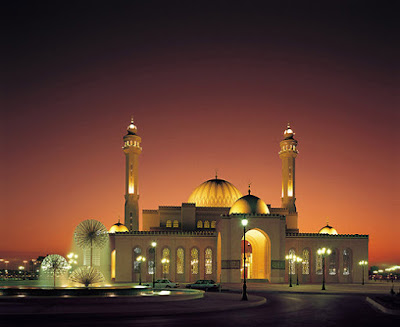Badshahi Masjid (Lahore-Pakistan)
Badshahi Masjid
(Lahore-Pakistan)
The Badshahi Mosque (بادشاہی ) or the 'Royal Mosque' in Lahore, commissioned by the sixth
Mughal Emperor Aurangzeb in 1671 and completed in 1673, is the second largest
mosque in Pakistan and South Asia and the fifth largest mosque in the world.
Epitomizing the beauty, passion and grandeur of the Mughal era, it is Lahore's
most famous landmark and a major tourist attraction. Capable of accommodating
5,000 worshippers in its main prayer hall and a further 95,000 in its courtyard
and porticoes, it remained the largest mosque in the world from 1673 to 1986 (a
period of 313 years), when overtaken in size by the completion of the Faisal
Mosque in Islamabad. Today, it remains the second largest mosque in Pakistan
and South Asia and the fifth largest mosque in the world after the Masjid
al-Haram (Grand Mosque) of Mecca, the Al-Masjid al-Nabawi (Prophet's Mosque) in
Medina, the Hassan II Mosque in Casablanca and the Faisal Mosque in Islamabad.
To appreciate its large size, the four minarets of the Badshahi Mosque are 13.9
ft (4.2 m) taller than those of the Taj Mahal and the main platform of the Taj
Mahal can fit inside the 278,784 sq ft (25,899.9 m2) courtyard of the Badshahi
Mosque, which is the largest mosque courtyard in the world. In 1993, the
Government of Pakistan recommended the inclusion of the Badshahi Mosque as a
World Heritage Site in UNESCO's World Heritage List, where it has been included
in Pakistan's Tentative List for possible nomination to the World Heritage List
by UNESCO. Construction of the Badshahi Mosque was ordered in May 1671 by the
sixth Mughal Emperor, Aurangzeb. Construction took about two years and was
completed in April 1673. The Badshahi Mosque was built opposite the Lahore
Fort, emphasising its stature in the Mughal Empire. It was constructed on a
raised platform to avoid inundation from the nearby Ravi River during flooding.
The mosque's foundation and structure was constructed using bricks and
compacted clay. The structure was then clad with red sandstone tiles brought
from a stone quarry near Jaipur in Rajasthan and its domes were clad with white
marble. The construction work was carried out under the supervision of
Aurangzeb's foster brother, Muzaffar Hussain (also known as Fidai Khan Koka),
who was appointed Governor of Lahore by Aurangzeb in May 1671 to specifically
oversee the construction of the mosque and held that post until 1675. He was
also Master of Ordnance to Aurangzeb. In conjunction with the building of the
Badshahi Mosque, a new gate was built at the Lahore Fort opening into the
Hazuri Bagh and facing the main entrance of the Badshahi Mosque, which was
named Alamgiri Gate after Aurangzeb.

